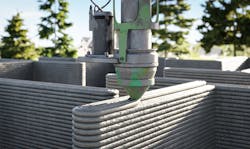Could 3D-Printed Homes Solve a Worsening Affordability Crisis?
For nearly a decade, 3D-printing capabilities have been limited to small, handheld items produced by desktop printers, but according to John Burns Real Estate Consulting, that process is now being replicated on a much larger scale to boost housing supply. While 3D-printed homes cost roughly the same as traditional stick-built houses, they can be constructed in a fraction of the time with significantly less waste.
Not only is the final product durable and efficient, but it can also be fully customized. As the technology advances and demand for 3D-printing grows, John Burns says 3D-printed homes will likely become more affordable and will include new and improved design features and amenities in the coming years.
- After the bones of the home are printed, the process is pretty normal so on-site completion is the same as a stick-built home.
- Weather is no more a problem for 3D printing than stick-built—it can be done anywhere at any time.
- Vertical costs are about the same, but 3D printing should get cheaper as processes improve and automation increases.
- A key cost that is not the same is time—3D homes are printed much faster than traditional homes are built.
- Waste is minimal—–the Mountain View Estates job site has no dumpsters.
